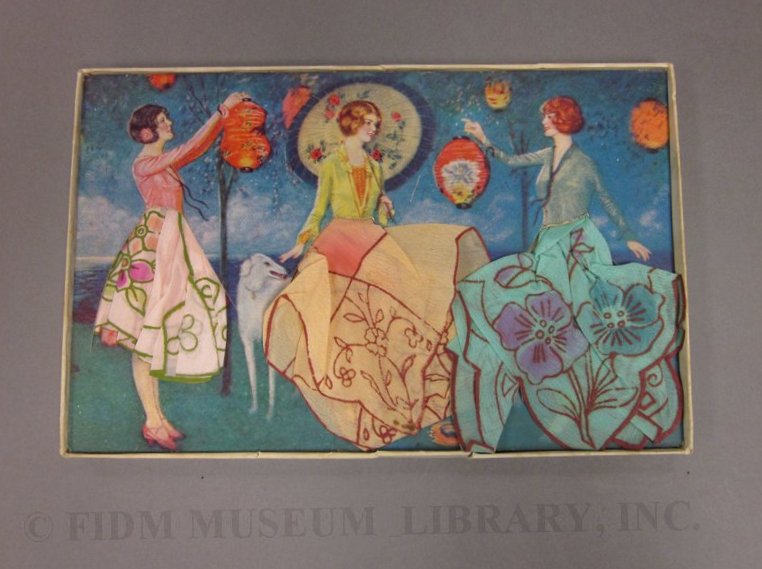These charmingly presented silk handkerchiefs prove that the whole is usually greater than the sum of its parts. Their colorful, festive packaging elevates them to something memorable. Carefully folded and arranged to form full skirts, the hand-painted handkerchiefs add dimensionality to a beguiling printed background. Because they're so prettily packaged, they probably retailed as a gift item. As declared in a 1924 Vogue advertisement: "Let that last-minute gift be Handkerchiefs! They
are always appropriate and sure to be appreciated."1
 Handkerchiefs
Handkerchiefs
c. 1926
Gift of Yvonne Sone
2010.796.1A-F
Like parasols, fans, and gloves, handkerchiefs have fallen out of fashion. If worn today, they are usually tucked inside a pocket, a colorful accent to a somber suit. The demise of the functional handkerchief began in 1924, the year Kleenex was introduced. At first, Kleenex was marketed as an alternative to the washcloths women used for make-up removal. Advertisements for "Kleenex Kerchiefs" offered a mail-in coupon good for a 7 day supply of the product, declaring it "the only way that removes ALL germ-laden accumulations from the pores."2 In the early 1930s, Kleenex shifted its marketing, proposing Kleenex as a sanitary alternative to cloth handkerchiefs. This change is clear in a 1932 ad: "Hay Fever misery relieved by soft, disposable tissues instead of damp, irritating handkerchiefs…use KLEENEX."3 The triumph of disposable Kleenex over reusable cloth is evident by how few people nowadays use cloth handkerchiefs for nasal hygiene.
In the 1920s, however, handkerchiefs proliferated. They were delicate silk squares tucked inside tiny handbags or large, folded triangles tied jauntily around the neck. According to a 1922 issue of Vogue, women's fashion incorporated handkerchiefs in unexpected places: "it may be a brilliant silk bandanna tied around the curls of the tennis player, or thrust through the belt of a gold enthusiast."4 Simple skirts and dresses were complicated by handkerchief hems, as seen in this 1921 sketch for a Lucile afternoon dress.
Panels or squares of material were attached to bodices and skirts,
fluttering like wings, or a gently waved handkerchief, when the wearer
moved.
Handkerchiefs also functioned as a canvas for artists to showcase their work. Rex Silver, a member of the family that founded the Silver Studio print works, designed a handkerchief featuring peacock feathers in 1920. Liberty & Co., renowned for their textile patterns, offered its customers a variety of printed handkerchiefs, including this sedate navy handkerchief, probably intended for a man's use. In the late 1930s, Jean Cocteau designed a Surrealist tribute to the handkerchief–a silk scarf hand-printed with disembodied hands waving handkerchiefs.
1 "James McCutcheon & Co. Advertisement." Vogue (Jan 1, 1924): 90.
2 "Kleenex Advertisement." Vogue (May 15, 1926): 13.
3 "Kleenex Advertisement." Vogue (Aug 15, 1932): 67.
4 Pfeiffer, Pauline. "Special Features: Handkerchiefs a Lady Loses." Vogue (Jul 1, 1922): 72.


